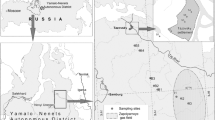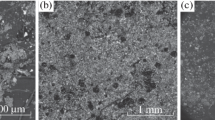Abstract
A geochemical study of snow from the industrial town of Maribor (Slovenia) was performed. Concentrations of 61 elements in meltwater were determined, and a detailed semi-quantitative and qualitative analysis of individual PTE-bearing particles deposited in snow was performed with SEM/EDS. The physico-chemical characteristics of meltwater reflect the influence of winter road maintenance (high electrical conductivity and high Ca and Na concentrations close to the main roads) and industrial activities. Particulate matter deposited in snow consists mainly of carbonates and silicates, followed by carbon-rich particles and PTE-bearing particles. A higher abundance of PTE-bearing particles is typical for the industrial zones. The size, morphology and chemical composition of 4415 PTE-bearing particles were studied. They were organised into nine groups based on their characteristics. The majority were assigned to the group of Fe-oxides, which includes mostly angular particles of unidentified origin. Several groups of particles of anthropogenic origin were determined, mainly from industrial metal-processing activities. These particles include spherical Fe-oxides, Fe-alloys, other metal alloys and spherical Si-particles. Spherical Fe-oxides are typical for the Tezno industrial zone, while Fe-alloys, namely Fe–Cr (Cu, Mn, Ni) shavings and other metal alloys (Cu–Zn (Cl, Fe) shavings) are typical for the Melje industrial zone. The presence of naturally occurring mineral particles (e.g. zircon, ilmenite, monazite) reflects the influence of natural/geogenic sources on the composition of particulate matter deposited in snow. The presented study confirmed that snow is a very promising medium for the geochemical study of urban environments, especially for the identification of anthropogenic sources of particulate matter.





Similar content being viewed by others
References
Ali, M. U., Liu, G., Yousaf, B., Ullah, H., Abbas, Q., & Munir, M. A. M. (2019). A systematic review on global pollution status of particulate matter-associated potential toxic elements and health perspectives in urban environment. Environmental Geochemistry and Health, 41, 1131–1162. https://doi.org/10.1007/s10653-018-0203-z.
ARSO. (2019). Slovenian Environment Agency, archival weather data, http://www.meteo.si/met/en/
Bell, T. (2014). Alloying elements in steel. Akron Steel Treating Company, 1–3, http://www.akronsteeltreating.com/docs/default-source/default-document-library/alloying-elements-in-steel-by-t-bell.pdf?sfvrsn=0
Bućko, M. S., Magiera, T., Johanson, B., Petrovsky, E., & Pesonen, L. J. (2011). Identification of magnetic particulates in road dust accumulated on roadsidesnow using magnetic, geochemical and micro-morphological analyses. Environmental Pollution, 159, 1266–1276. https://doi.org/10.1016/j.envpol.2011.01.030.
Budhavant, K. B., Rao, P. S. P., & Safai, P. D. (2014). Chemical composition of snow-water and scavenging ratios over Costal Antarctica. Aerosol and Air Quality Research, 14, 666–676. https://doi.org/10.4209/aaqr.2013.03.0104.
Calvo, A. I., Alves, C., Castro, A., Pont, V., Vicente, A. M., & Fraile, R. (2013). Research on aerosol sources and chemical composition: Past, current and emerging issues. Atmospheric Research, 120–121, 1–28. https://doi.org/10.1016/j.atmosres.2012.09.021.
Elik, A. (2002). Monitoring of heavy metals in urban snow as indicator of atmosphere pollution. International Journal of Environmental Analytical Chemistry, 82, 37–45. https://doi.org/10.1080/03067310290024085.
Engelhard, C., De Toffol, S., Lek, I., Rauch, W., & Dallinger, R. (2007). Environmental impacts of urban snow management—The alpine case study of Innsbruck. Science of the Total Environments, 382, 286–294. https://doi.org/10.1016/j.scitotenv.2007.04.008.
Gaberšek, M., & Gosar, M. (2018). Geochemistry of urban soil in the industrial town of Maribor, Slovenia. Journal of Geochemical Exploration, 187, 141–154. https://doi.org/10.1016/j.gexplo.2017.06.001.
Giaccio, L., Cicchella, D., De Vivo, B., Lombardi, G., & De Rosa, M. (2012). Does heavy metals pollution affects semen quality in men? A case of study in the metropolitan area of Naples (Italy). Journal of Geochemical Exploration, 112, 218–225. https://doi.org/10.1016/j.gexplo.2011.08.009.
Jaishankar, M., Tseten, T., Anbalagan, N., Mathew, B. B., & Beeregowda, K. N. (2014). Toxicity, mechanism and health effects of some heavy metals. Interdisciplinary Toxicology, 7, 60–72. https://doi.org/10.2478/intox-2014-0009.
Karagulian, F., Belis, C. A., Dora, C. F. C., Prüss-Ustün, A. M., Bonjour, S., Adair-Rohani, H., et al. (2015). Contributions to cities’ ambient particulate matter (PM): A systematic review of local source contributions at global level. Atmospheric Environment, 120, 475–483. https://doi.org/10.1016/j.atmosenv.2015.08.087.
Kuoppamäki, K., Setälä, H., Rantalainen, A. L., & Kotze, D. J. (2014). Urban snow indicates pollution originating from road traffic. Environmental Pollution, 195, 56–63. https://doi.org/10.1016/j.envpol.2014.08.019.
Miler, M., & Gosar, M. (2009). Characterisation of solid airborne particles in urban snow deposits from Ljubljana by means of SEM/EDS. RMZ-Materials and Geoenvironment, 56, 266–282.
Miler, M., & Gosar, M. (2013). Assessment of metal pollution sources by SEM/EDS analysis of solid particles in snow: A case study of Žerjav, Slovenia. Microscopy and Microanalysis, 19, 1606–1619. https://doi.org/10.1017/S1431927613013202.
Miler, M., & Gosar, M. (2015). Chemical and morphological characteristics of solid metal-bearing phases deposited in snow and stream sediment as indicators of their origin. Environmental Science and Pollution Research, 22, 1906–1918. https://doi.org/10.1007/s11356-014-3589-x.
Miler, M., & Gosar, M. (2019). Assessment of contribution of metal pollution sources to attic and household dust in Pb-polluted area. Indoor Air, 29, 487–498. https://doi.org/10.1111/ina.12548.
Qiu, P., & Leygraf, C. (2011). Initial oxidation of brass induced by humidified air. Applied Surface Science, 258, 1235–1241. https://doi.org/10.1016/j.apsusc.2011.09.080.
Radinja, D. (1987). Snežna odeja v SR Sloveniji sredi decembra 1986 ter vprašanje onesnaženosti našega okolja (Snow cover in SR Slovenia in middle of December in 1986 and the question of pollution of our environment). Geografski vestnik, 59, 21–35.
Reinosdotter, K., & Viklander, M. (2005). A comparison of snow quality in two Swedish municipalities—Luleå and Sundsvall. Water, Air, and Soil Pollution, 167, 3–16. https://doi.org/10.1007/s11270-005-8635-3.
Ruth, O. (2003). The effects of de-icing in Helsinki urban streams, Southern Finland. Water Science and Technology, 48(9), 33–43. https://doi.org/10.2166/wst.2003.0486.
Sokol, E. V., Kalugin, V. M., Nigmatulina, E. N., Volkova, N. I., Frenkel, A. E., & Maksimova, N. V. (2002). Ferrospheres from fly ashes of Chelyabinsk coals: Chemical composition, morphology and formation conditions. Fuel, 81, 867–876. https://doi.org/10.1016/S0016-2361(02)00005-4.
Tack, F. M. G. (2010). Trace elements: General soil chemistry, principles and processes. In P. S. Hooda (Ed.), 2010 (pp. 9–37). Wiley, UK: Trace elements in soils.
Talovskaya, A. V., Yazikov, E. G., Filimonenko, E. A., Lata, J. C., Kim, J., & Shakhova, T. S. (2017). Characterization of solid airborne particles deposited in snow in the vicinity of urban fossil fuel thermal power plant (Western Siberia). Environmental Technology, 39(18), 2288–2303. https://doi.org/10.1080/09593330.2017.1354075.
Telloli, C. (2014). Metal concentrations in snow samples in an urban area in the Po Valley. International Journal of Geosciences, 5, 1116–1136. https://doi.org/10.4236/ijg.2014.510095.
Teran, K., Žibret, G., & Fanetti, M. (2019). Impact of urbanization and steel mill emissions on elemental composition of street dust and corresponding particle characterization. Journal of Hazardous Materials. https://doi.org/10.1016/j.jhazmat.2019.120963. (in press).
Thorpe, A., & Harrison, R. M. (2008). Sources and properties of non-exhaust particulate matter from road traffic: A review. Science of the Total Environment, 400, 270–282. https://doi.org/10.1016/j.scitotenv.2008.06.007.
Umbria, A., Galán, M., Muñoz, M. J., & Martín, R. (2004). Characterization of atmospheric particles: Analysis of particles in the Campo de Gibraltar. Atmósfera, 17, 191–206.
Vučinić-Vasić, M., Mihailović, A., Kozmidis-Luburić, U., Nemes, T., Ninkov, J., Zeremski-Škorić, T., et al. (2012). Metal contamination of short-term snow cover near urban crossroads: Correlation analysis of metal content and fine particles distribution. Chemosphere, 86, 585–592. https://doi.org/10.1016/j.chemosphere.2011.10.023.
Zhang, Y., & Edwards, M. (2011). Effects of pH, chloride, bicarbonate, and phosphate on brass dezincification. Journal AWWA, 103, 90–102. https://doi.org/10.1002/j.1551-8833.2011.tb11438.x.
Žibret, G. (2018). Influences of coal mines, metallurgical plants, urbanization and lithology on the elemental composition of street dust. Environmental Geochemistry and Health, 41, 1489–1505. https://doi.org/10.1007/s10653-018-0228-3.
Acknowledgements
The presented study was funded by the Slovenian Research Agency (ARRS) in the frames of the young researcher programme, the research Groundwater and Geochemistry programme (P1-0020) and the research project “Dynamics and matter flow of potentially toxic elements (PTEs) in urban environment” (J1-1713).
Author information
Authors and Affiliations
Corresponding author
Additional information
Publisher's Note
Springer Nature remains neutral with regard to jurisdictional claims in published maps and institutional affiliations.
Rights and permissions
About this article
Cite this article
Gaberšek, M., Gosar, M. Meltwater chemistry and characteristics of particulate matter deposited in snow as indicators of anthropogenic influences in an urban area. Environ Geochem Health 43, 2583–2595 (2021). https://doi.org/10.1007/s10653-020-00609-z
Received:
Accepted:
Published:
Issue Date:
DOI: https://doi.org/10.1007/s10653-020-00609-z




